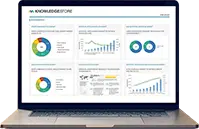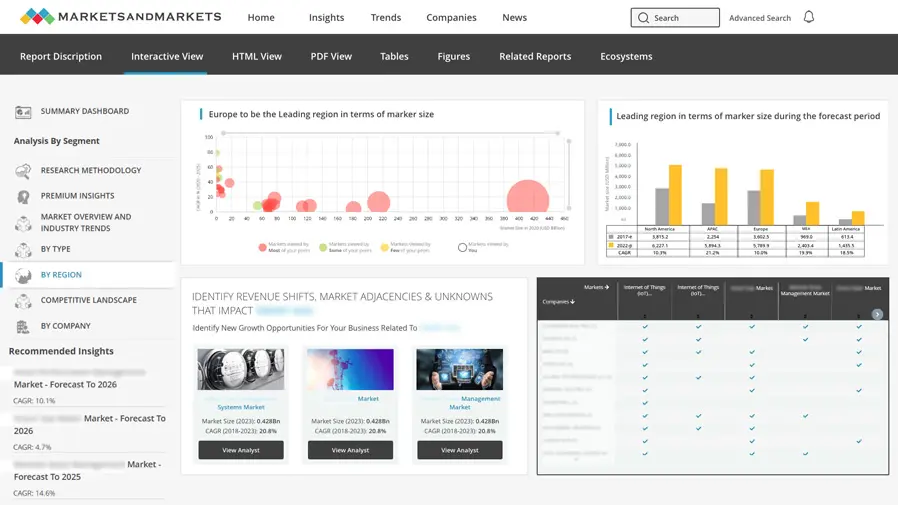Investigative Analytics Market - Global Forecast to 2029
The Investigative Analytics Market is expected to experience rapid growth during the forecast period of 2024 to 2029, driven by a strong compound annual growth rate (CAGR) of XX%. The expansion of the investigative analytics market is driven by various factors associated with the rising intricacy of data and the need for improved decision-making.
The improvements in data processing, artificial intelligence, and machine learning technologies enable crime forensics teams to examine extensive datasets and derive actionable insights quickly. The extensive use of digital devices, online engagements, and interconnected systems has produced considerable evidence trails, resulting in the need for advanced analytical tools. Investigative analytics assists in pattern recognition, anomaly detection, and predictive analysis, aiding in solving complex criminal cases. These tools help forensic teams address both traditional and digital crimes effectively and solve complex crime cases. Techniques like social network analysis, metadata analysis, and biometric verification link suspects, reconstruct timelines for crimes and pinpoint criminal networks. Efficiency and accuracy are, therefore, greatly enhanced in modern investigations.

To know about the assumptions considered for the study, Request for Free Sample Report

Impact of Generative AI on the Investigative Analytics Market
Generative AI is revolutionizing the Investigative Analytics market by facilitating a quicker, more precise understanding of intricate data patterns and unstructured information. Integrating large volumes of data speeds up the detection of anomalies identifies fraud, and improves predictive analytics, thereby enhancing decision-making in areas such as finance, law enforcement, and cybersecurity. Sophisticated natural language processing enables generative AI to analyze legal documents, emails, and social media content to uncover hidden relationships, reveal intentions, or forecast risks with unmatched accuracy. Its capacity to generate artificial datasets for testing and simulation enhances scenario planning and the validation of investigative hypotheses.

Investigative Analytics Market Dynamics
Driver: Rising Demand for Analytics Tools in Cybercrime and Forensic Investigations
The increase in cybercrime, fraud, and data breaches has significantly increased the demand for investigative analytics tools in crime forensics. Contemporary crimes, such as online fraud, identity theft, phishing, and cyber-attacks, utilize digital platforms to avoid detection. Forensic teams depend on sophisticated analytic tools integrated with machine learning, AI, and big data to analyze extensive information, reveal patterns, and track criminal behaviors. These tools assist law enforcement in revealing concealed fraud, examining behavioral irregularities, and charting the relationships tied to organized crime. As cybercriminal methods become increasingly advanced, investigative analytics play a critical role in predicting threats, deterring crimes, and offering practical insights for resolving complex cases. The growing complexity and impact of cybercrime highlight the essential importance of advanced analytics in contemporary forensic investigations, rendering these tools vital for addressing digital and cybercriminal offenses.
Restraint: Implementing Investigative Analytics into Existing Systems
The restraint of integrating investigative analytics into existing processes poses a significant limitation in the market. Incorporating sophisticated investigative tools into existing workflows typically necessitates significant customization. This customization procedure can be lengthy and expensive, necessitating specialized knowledge in both the technical components of analytics and industry-specific expertise. Moreover, customized training is essential to ensure employees can use these advanced tools effectively. This training is crucial for grasping the software and accurately interpreting data insights, which can present a significant learning challenge for numerous users. The combined challenges of integration, customization, and training create significant barriers to adoption. As a result, the intricacy and related expenses of deploying investigative analytics could discourage potential users, hindering market expansion and restricting the widespread adoption of these potent tools.
Opportunity: Integration of AI and Big Data with Investigative Tools
The combination of AI and big data with investigative tools creates a revolutionary change in investigative analytics. By utilizing AI technologies like machine learning and natural language processing, researchers can scrutinize extensive datasets with greater precision and efficiency, revealing concealed patterns and insights that might go unnoticed. AI-driven predictive analytics can anticipate possible outcomes using historical data, allowing investigators to focus on leads and distribute resources more efficiently. Additionally, big data enables the integration of large and varied data sets, including social media engagements, financial documents, and surveillance information, which can be vital in contemporary investigations. AI-driven models can examine this data, uncovering correlations, trends, and anomalies that yield new insights or even predict criminal activities before they occur. The ability to continue learning from new data improves the accuracy of these tools as time goes on. This integration enhances the speed and precision of investigations, facilitating more informed decision-making that fundamentally alters the conduct of investigations and significantly improves outcomes in law enforcement and corporate sectors.
Challenge: Complexities in Standardizing and Integrating Diverse Datasets in Crime Forensics
Crime forensics has to integrate multiple data sources, including criminal records, digital forensics, social media, and documents available in the public domain. All these datasets are in different formats, structures, and reliability, making integration difficult. For instance, data from social media usually needs to be tidier and more chaotic, whereas public records are more organized and prone to errors. Digital evidence, such as logs or messages, introduces complexity because of its different formats. This diversity necessitates advanced techniques to align formats, schemas, and detail levels while maintaining accuracy. Digital evidence can easily surpass conventional systems and dispersed or irregular records often hinder analysis. Analytical investigations depend on precise, organized data to reveal patterns, discern relationships, and generate actionable insights. Addressing these challenges requires strong data processing technologies, machine learning approaches, and customized governance structures to guarantee dependable results in criminal investigations.
Investigative Analytics Market Ecosystem
The Investigative analytics market ecosystem comprises a diverse range of stakeholders. Key players include learning cyber fraud investigation tools, AI image and video analytics tool providers, crime mapping and geospatial analytics tool providers, service providers, and end users. These entities collaborate to develop, deliver, and utilize investigative analytics tools, driving innovation and growth in the market.

To know about the assumptions considered for the study, download the pdf brochure
By offering, the software segment will lead the market share during the forecast period.
The software segment will dominate the investigative analytics market, offering advanced tools for data analysis, visualization, and predictive modeling. Analytical tools for investigations are essential for efficiently analyzing extensive datasets, identifying trends, and obtaining valuable insights across different domains. They provide scalability, smooth integration with current systems, and improved user accessibility via cloud-based solutions. The rising demand for real-time analytics makes AI and machine learning-enabled software solutions necessary, further increasing their adoption. The continuous innovation in software capabilities ensures its relevance, propelling market growth.
By application, the AI image & video analytics will register the highest CAGR during the forecast period.
AI image and video analytics are expected to record the highest compound annual growth rate in the investigative analytics market because of their increasing usage in automating the analysis of large volumes of visual data. These technologies rely on AI algorithms to detect patterns, identify anomalies, and provide real-time insights from images and videos. This further enhances the investigation processes of end users like law enforcement and security by requiring more efficient, accurate, and scalable analytics solutions. AI-driven image and video analytics will drive demand for faster and more precise investigation decision-making.
By end user, the law enforcement agencies segment will lead the market during the forecast period
This law enforcement agencies segment will likely maintain its dominance in the investigative analytics market during the forecast period since there is a rising need for advanced technologies to fight against crime and ensure public safety. Investigative analytics is known to help law enforcement agencies swiftly analyze large amounts of data, unveiling patterns of criminal activities and monitoring these trends to solve cases much faster. Along with the increased rate of cybercrime, terrorism, and other complex crime networks, law enforcement agencies are highly adopting these tools for data-driven decision-making to improve investigative results.
By region, North America holds the largest market share in the Investigative analytics market during the forecast period
North America is a major contributor to the investigative analytics market for several reasons. The region has advanced technological infrastructure, a strong regulatory environment, and high investment in analytics solutions. The core users use these technologies in the fight against fraud and compliance and for better decision-making. Strong market players and innovation centers contribute to the growth. Increasing cases of cybercrime and fraud in North America require the growing investigative analytics tools market. Various Government agencies also consider the data-driven approach for security and risk management more significantly and, therefore, tend to dominate the region's adoption and expansion of this market.

Key Market Players
Cellebrite, LexisNexis, Motorola Solutions, OpenText, Cognyte, SAS Institute, NICE, Palantir, DataWalk, West Advanced Technologies,
Recent Developments:
- In September 2024, Cellebrite partnered with Amazon Web Services (AWS) to enhance its investigative analytics solutions. This partnership will leverage AWS's advanced cloud technologies to improve the speed, scalability, and security of Cellebrite's data processing capabilities, enabling law enforcement and enterprises to conduct more efficient digital investigations. The integration aims to provide seamless, cloud-based solutions to analyze and act on digital evidence
- In July 2024, Cognyte partnered with Four Inc. to deliver investigative analytics solutions to the public sector. Their collaboration will make Cognyte’s NEXYTE platform, which helps analyze data for better decision-making, available through Four Inc.'s government contracts. This partnership aims to enhance investigative capabilities for law enforcement and national security agencies, focusing on risk assessment and optimizing resources.
- In February 2024, SAS partnered with Carahsoft to offer its advanced analytics, AI, and data management solutions to the public sector. The aim is to enhance investigative analytics capabilities, enabling government agencies to leverage SAS's technology for improved decision-making, data analysis, and operational efficiency in investigations. The partnership will support agencies in addressing complex challenges through data-driven insights.
- In January 2024, Palantir and Parexel broadened their collaboration to speed up clinical research by utilizing advanced data analytics and AI. The partnership focuses on enhancing investigative analytics to optimize clinical trial results and processes. By harnessing Palantir's data platforms, they aim to provide faster, more precise insights into clinical data, improving decision-making and efficiency in drug development.
- In March 2023, Cellebrite's latest enhancements to its investigative solutions include the integration of AI-powered analytics with cloud-based options. This update accelerates the identification of critical evidence and streamlines digital investigations with automated translation, image recognition, and powerful search tools.
Frequently Asked Questions (FAQ):
What are the opportunities for the Investigative analytics market?
Define the Investigative analytics market.
Which region is expected to have the largest share in the Investigative analytics market?
Which are the major market players covered in the report?
How big is the global Investigative analytics market today?
















Growth opportunities and latent adjacency in Investigative Analytics Market